|
|
ARTHROPODS:
Insects»
Spiders»
Centipedes»
Millipedes»
Sowbugs»
Harvestmen»
Mites
& Ticks»
Scorpions»
Identification
Tips»
About
the Critter Files»
Links» |
|
|
|
 |
COBWEB
SPIDERS
Critter
Files/Spiders/Cobweb Spiders
By Blake Newton
University of Kentucky Department of Entomology |
| |
|
| Cobweb
Spiders can be difficult to distinguish from other kinds
of web-building spiders, especially orb
weavers. |
|
| The main difference:
webs made by cobweb spiders appear messy and disorganized, unlike
the organized, circular webs made by orb-weavers and many other
web-building spiders. In addition, cobweb spiders often have
abdomens that are comparatively larger and more spherical than orb-weavers.
Cobweb spiders have 8 eyes and (like all spiders), they have
8 legs, 2 body parts, and fang-like mouthparts called "chelicerae."
|
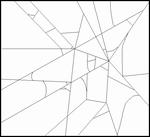 Typical Cob Web
Typical Cob Web |
|
| SIZE:
Body length up to about 1/2" |
| |
| LIFE
CYCLE |
|
Simple
metamorphosis: like all spiders, young cobweb spiders hatch from
eggs and look like tiny adults. They shed their skin as they
grow. Many cobweb spiders live for less than 1 year. At
the end of the summer, many types of female cobweb spiders produce a large amount
of eggs that they wrap in an eggsac made of silk. In many species, the young
spiders hatch in the spring. |
| |
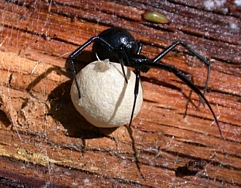
Black widow
spider with eggsac (B. Newton, 2004) |
| |
| ECOLOGY |
|
Cobweb spiders are
very common in Kentucky and can be found almost anywhere that they
can find weeds, fences, trees, walls, or other upright structures
to build their webs. Cobweb spiders are predators, and they
will eat almost anything that is small enough to get trapped in
their webs. Like most web-building spiders, cobweb spiders
tend to have poor vision--they don't need to see very well because
they can "feel" prey when it gets caught in their webs.
|
| |
| PEST
STATUS |
|
Most cobweb
spiders are considered beneficial to humans. They eat flies,
mosquitoes, and other creatures. However, The black widow
spider is a cobweb spider, and its bite can be dangerous. Read
more about black widow and other common spiders of medical significance by visiting our
ENTfact: Common
Spiders Found Around Homes and Buildings.
No other Kentucky cobweb
spiders are known to have venom that is medically significant to humans (remember,
though, that all spiders can be dangerous if a person is allergic or sensitive to
spiders and insects). |
| |
| COMMON
KENTUCKY COBWEB SPIDERS |
|
| There are
many different species of cobweb spiders in Kentucky. Most are
similar in shape, but exhibit a wide array of color patterns. Shown
here are some of the most common and distinctive varieties. |
|
|
BLACK
WIDOWS
GENUS: Latrodectus
Black Widows,
with their shiny black bodies and bright red markings, are among our most distinctive cobweb spiders. Below left is a female
black widow. The male is below right. Males have a more
vibrant pattern on their abdomen than females, with many red and
white spots. Male black widow spiders are rarely encountered,
and are not known to bite humans. There are two species of
black widow found in Kentucky, the Northern and
Southern Black Widow. Both species have shiny
black bodies with red markings, and both are in the genus Latrodectus.
Black widows are fairly large cobweb spiders, with body lengths
up to about 1/2."
|
| |
 Female Black
Widow Spider (R. Bessin, 2000)
Female Black
Widow Spider (R. Bessin, 2000) |
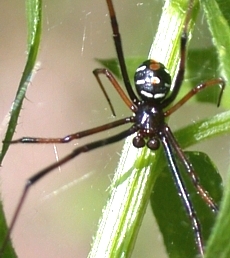 Male Black Widow
Spider (B. Newton, 2004)
Male Black Widow
Spider (B. Newton, 2004) |
|
|
|
AMERICAN
HOUSE SPIDER
GENUS and SPECIES:
Parasteatoda tepidariorum
The American House
Spider, Parasteatoda tepidariorum (previously Achaearanea tepidariorum), also called the Common House Spider,
is a typical cobweb spider. It is also one of the most
commonly encountered cobweb spiders in urban areas, and can be found in almost every garage,
barn, and attic in Kentucky. It is harmless, and it catches
and eats flies, mosquitoes, and other pests that enter buildings. It is an average-sized cobweb spider, with a body length up
to about 1 cm. |
| |
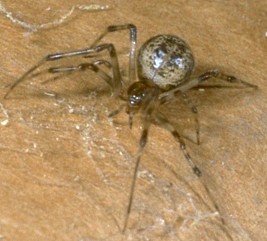 American House
Spider (R. Bessin, 2000)
American House
Spider (R. Bessin, 2000) |
|
|
|
THERIDULA
sp.
GENUS: Theridula
Pictured below is a tiny
(5 mm) cobweb spider in the Theridula
genus. It is commonly found under leaves in meadows and other
sunny, weedy habitats. We have other spiders in this genus
as well. Most have similar patterns and body shapes, but with
different color combinations. One species has a yellow spot
on a red background, with black legs.
|
| |
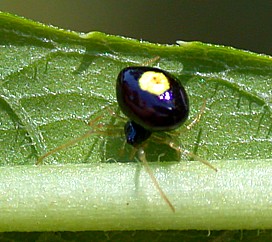 Cobweb spider
in the Theridula genus (B. Newton 2003)
Cobweb spider
in the Theridula genus (B. Newton 2003) |
|
|
|
Spintharus flavidus
GENUS and SPECIES: Spintharus flavidus
While many types of cobweb spiders have predominantly dark coloration, a few species are brightly colored.Pictured below is Spintharus flavidus, a medium-sized (body apx 5mm long) cobweb spider that is found in low vegetation and at the woods edge. It has vivid black, red, and yellow markings on the abdomen, while the body color ranges from pale yellow to bright yellow-green. This image was taken at the Land Between The Lakes area by John Hewlett from Murray State University in August 2017.
|
| |
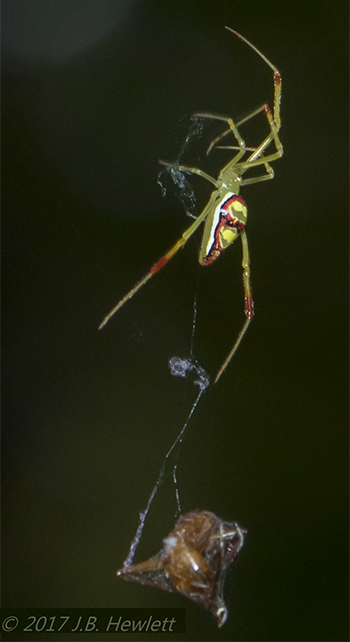 Spintharus flavidus with prey (J. Hewlett, 2017)
Spintharus flavidus with prey (J. Hewlett, 2017) |
|
| |
| COLLECTING
& PHOTOGRAPHY |
|
Cobweb spiders are
very common in all kinds of vegetation. They can also be found
near buildings. Cobweb spiders and orb weavers often inhabit
the same types of habitats. If anything, cobweb spiders may
be more common and easier to find than orb-weavers, especially around
buildings and other man-made structures.
As long as you do not
disturb them, cobweb spiders will remain still for a photograph.
Remember: no spider should ever be picked up by hand. All
spiders are best preserved in alcohol. |
| |
| COBWEB
SPIDER FACTS |
|
Although many kinds
of web-building spiders are able to chew their food, cobweb spiders
are only able to suck fluids out of their prey. |
| |
| MYTHS
- LEGENDS - FOLKLORE |
|
It is widely believed
that black widow females always eat males after mating. Although
this sometimes happens, black widow males are often able to escape
before being eaten. Sometimes, the female makes no attempt to
eat the male.
|
| |
Original document: 25 May 2004
Last updated: 23 Jan 2018
Photos courtesy R.
Bessin and B. Newton, University of Kentucky
The Kentucky Critter Files are maintained
by Blake Newton, Department of Entomology, University of Kentucky.
Contact: blaken@uky.edu |
|

